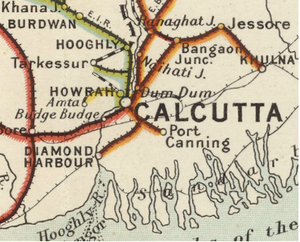Howrah-Amta Light Railway
| Howrah-Amta Light Railway | ||
|---|---|---|
| [[Image:|150px| ]] | ||
| Line of route | ||
| Howrah to Amta | ||
| Gauge / mileage | ||
| 2' 0" NG | 37 miles (1905) 42 miles (1943) | |
| Timeline | ||
| 1898 | Line opened to traffic | |
| 1971 | Closed | |
| Key locations | ||
| Presidency | Bengal | |
| Stations | Howrah, Amta | |
| System agency | ||
| Worked by Martin's Light Railways | ||
| How to interpret this infobox | ||
The Howrah-Amta Light Railway (HALR) was a short 2ft/610mm narrow gauge(NG) railway which ran from Howrah westwards to Amta. [1]

The HALR was one of several small narrow gauge concerns owned and worked by Martin's Light Railways, a management company based in Calcutta. [2]
History
On 12 June 1889 an agreement was signed between the District Board of Howrah and Messrs. Walsh, Lovett & Company on behalf of the Bengal District Road Tramways Company; this gave the Company the right to construct and work a tramway over a portion of roads [1]. This was subsequently renewed with Martin's Light Railways Co Ltd and sanctioned by Government notification in the Calcutta Gazette of 27 March 1895 [2]. On the 2 May 1895 the 'Howrah-Amta Light Railway Company’ was formed and worked by Martin's Light Railways (MLR).
The Howrah-Amta line was opened up to Domjur in 1897, and to Amta in 1898. An extension from Bargachhia (Bargechhe) junction to Antpur was opened in 1904, and a further extension to Champadanga in 1908, giving a total line length of 44 miles (70km) [1].
The Howrah- Amta Light and the Howrah-Sheakhalla Light Railways start from Telkalghat on the Hooghly river, and skirting the Court maidan pass through the crowded Panchanantala road to Kadamtala station. Here they separate, the Howrah-Sliiakhala line running north-west along the Benares road to the border of the district, and thence to Shiakhala in Hooghly district. The Howrah-Amta line runs west, chiefly along the side of the Jagatballabhpur road, and then goes south-west to Amta [2].
The lines continued to operate privately long after Independence in 1947, and finally converted to Broad Gauge and electrified from 1984 onwards [2].
References
- ↑ 1.0 1.1 1.2 "Administration Report on the Railways in India – corrected up to 31st March 1918"; Superintendent of Government Printing, Calcutta; page 243; Retrieved 31 Aug 2016
- ↑ 2.0 2.1 2.2 2.3 Wikipedia"Martin's Light Railways"; Retrieved 31 Aug 2016